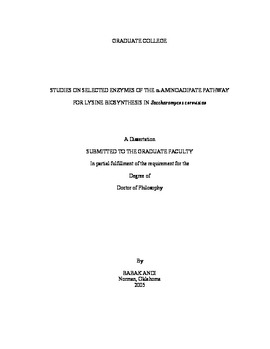| dc.contributor.advisor | West, Ann H., | en_US |
| dc.contributor.advisor | Cook, Paul F., | en_US |
| dc.contributor.author | Andi, Babak. | en_US |
| dc.date.accessioned | 2013-08-16T12:19:57Z | |
| dc.date.available | 2013-08-16T12:19:57Z | |
| dc.date.issued | 2005 | en_US |
| dc.identifier.uri | https://hdl.handle.net/11244/944 | |
| dc.description.abstract | Homocitrate synthase (HCS) catalyzes one of the regulated steps of the alpha-aminoadipate pathway for Lys biosynthesis in fungi. His-tagged HCS from Saccharomyces cerevisiae was purified to about 98% using a Ni-NTA resin and stabilized. The enzyme, in the absence of reactants, self associates, as suggested by size exclusion chromatography. Fluorescence and circular dichroic spectra suggested a partially exposed Trp residue and a mixed (alpha/beta) secondary structure for the enzyme. Fluorescence quenching studies with KI, CsCl, and acrylamide, suggest that the microenvironment around the single Trp residue of the enzyme has some positive charge. | en_US |
| dc.description.abstract | The kinetic mechanism of regulation of HCS from S. cerevisiae by Na+ and the feedback inhibitor Lys was studied by measuring the initial rate in the absence and presence of the effectors. Data suggest that Na+ is an activator at low concentrations and an inhibitor at high concentrations, and these effects occur as a result of the monovalent ion binding to two different sites in the free enzyme. Inhibition and activation by Na+ can occur simultaneously. The inhibition by Na+ is eliminated at high concentrations of AcCoA, the second substrate bound, but the activation remains. Fluorescence binding studies indicate Lys binds with high affinity to its binding site as an inhibitor. The inhibition by Lys is competitive and linear vs. alpha-Kg. The effects of Na+ and Lys are independent of one another. A model is developed for regulation of HCS that takes into account all of the effects discussed above. The rate equations that predict the regulatory kinetic behavior of HCS are also derived, and simulation of the predicted behavior is carried out over a range of values for the kinetic parameters. (Abstract shortened by UMI.) | en_US |
| dc.description.abstract | Kinetic data have been collected suggesting a preferred sequential ordered kinetic mechanism for the His-tagged HCS from S. cerevisiae with alpha-Kg binding before AcCoA and CoA released before Hc. In agreement with the ordered kinetic mechanism desulfo-CoA is uncompetitive and citrate is competitive vs. alpha-Kg. Varying AcCoA, citrate is a noncompetitive inhibitor as predicted, but CoA is noncompetitive vs. AcCoA suggesting binding of CoA to E:Hc and E:alpha-Kg. The product CoA behaves identical to desulfo-CoA, suggesting an E:alpha-Kg:CoA dead-end complex. Data further suggest an irreversible reaction overall. Fluorescence titration data show finite binding of CoA and AcCoA to free enzyme, suggesting the mechanism may be random with a high degree of synergism of binding between the reactants. | en_US |
| dc.format.extent | xxii, 201 leaves : | en_US |
| dc.subject | Saccharomyces cerevisiae. | en_US |
| dc.subject | Biosynthesis. | en_US |
| dc.subject | Lysine Synthesis. | en_US |
| dc.subject | Chemistry, Biochemistry. | en_US |
| dc.subject | Enzymes. | en_US |
| dc.subject | Biophysics, General. | en_US |
| dc.title | Studies on selected enzymes of the alpha-aminoadipate pathway for lysine biosynthesis in Saccharomyces cerevisiae. | en_US |
| dc.type | Thesis | en_US |
| dc.thesis.degree | Ph.D. | en_US |
| dc.thesis.degreeDiscipline | Department of Chemistry and Biochemistry | en_US |
| dc.note | Source: Dissertation Abstracts International, Volume: 66-12, Section: B, page: 6588. | en_US |
| dc.note | Advisers: Paul F. Cook; Ann H. West. | en_US |
| ou.identifier | (UMI)AAI3203304 | en_US |
| ou.group | College of Arts and Sciences::Department of Chemistry and Biochemistry | |
